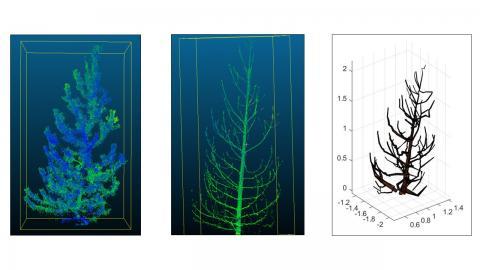Using destructive samplings methods and a Leica BLK360 terrestrial lidar scanner (TLS), we measured and scanned 20 small diameter trees. We then compare our lab-based results to the 3D quantitative structure model output retrieved from inputting our point clouds into TreeQSM code.
Airborne laser scans (ALS; also referred to as airborne LiDAR) have been a multi-purpose tool used for several decades in the world of forest research and management, most commonly for forest structure and inventory and More recently, terrestrial laser scans (TLS; also referred to as terrestrial LiDAR) have become more common in forest research.
For this project, 20 small diameter trees were cut at ground height and brought to the lab. As individuals, they were placed upright in a tree stand and measured for height, basal diameter above the lip of the stand, and diameter-at-breast-height (if applicable). 3 branches from each tree were further measured for length and diameter at base and tip. The trees were scanned from opposing sides using a Leica BLK360 TLS, and then stripped of their foliage, with the needles from the identified branches being placed in separate paper bags than the rest of the tree. The bare trees were once more scanned from the same locations. Following the second scan, the trees were dismantled and placed into aluminum pans for placing in the drying ovens. The 3 branches were placed in individual pans. Foliage and woody fuel were dried for 5 days at 105 degrees Celsius, removed, and weighed. The Leica BLK360 scans were uploaded using the Autodesk Recap Pro program, and the point cloud datasets clipped in the program CloudCompare. TreeQSM was then run on the revised point cloud datasets and used to reconstruct the trees through 3D quantitative structure models. TreeQSM outputs of volume and structure will then be compared to the lab sampled trees as well as for the individually sampled branches.
